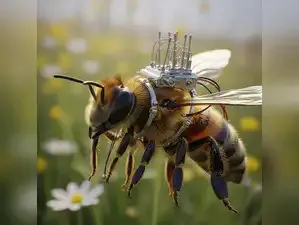Chinese researchers have developed the world’s lightest brain control device that can precisely direct a bee’s movement, according to a report by South China Morning Post. The technology, led by Professor Zhao Jieliang’s team at the Beijing Institute of Technology, was published on June 11 in the Chinese Journal of Mechanical Engineering.
The brain control device weighs only 74 milligrams, which is lighter than the nectar a bee can carry. It is fixed on the bee’s back and connects to its brain using three fine needles. Electrical signals sent through the device create artificial cues, guiding the bee to turn, move forward, or reverse. In tests, bees responded accurately to commands in nine out of ten attempts.
“Insect-based robots inherit the superior mobility, camouflage capabilities and environmental adaptability of their biological hosts,” Zhao and colleagues wrote. “Compared to synthetic alternatives, they demonstrate enhanced stealth and extended operational endurance, making them invaluable for covert reconnaissance in scenarios such as urban combat, counterterrorism and narcotics interdiction, as well as critical disaster relief operations.”
Zhao’s team advanced the technology by printing circuits on an ultra-thin flexible film, nearly as thin as an insect wing. This film holds multiple chips, including one for infrared remote control, allowing more complex commands.
In experiments, the device worked across nine pulse patterns. The researchers matched signals with movements in both bees and cockroaches. Bees could be steered mid-air, and cockroaches walked along defined paths with little deviation.
Zhao’s team acknowledged these issues and said more work is needed to refine the system. “In future research, precision and repeatability of insect behaviour control will be enhanced by optimising stimulation signals and control techniques,” they wrote.
They also plan to improve the technology further. “Concurrently expanding functional modules of the control backpack will improve environmental perception capabilities of insect-based robots, advancing their deployment in complex operational settings such as reconnaissance and detection missions.”
The brain control device weighs only 74 milligrams, which is lighter than the nectar a bee can carry. It is fixed on the bee’s back and connects to its brain using three fine needles. Electrical signals sent through the device create artificial cues, guiding the bee to turn, move forward, or reverse. In tests, bees responded accurately to commands in nine out of ten attempts.
Built on bee’s natural efficiency
Worker bees are known for their strength and range, capable of flying up to 5 kilometres while carrying nectar loads that weigh as much as 80% of their body mass. The researchers used this natural efficiency to create a high-performance robotic system.“Insect-based robots inherit the superior mobility, camouflage capabilities and environmental adaptability of their biological hosts,” Zhao and colleagues wrote. “Compared to synthetic alternatives, they demonstrate enhanced stealth and extended operational endurance, making them invaluable for covert reconnaissance in scenarios such as urban combat, counterterrorism and narcotics interdiction, as well as critical disaster relief operations.”
Lighter and more advanced than earlier designs
Before this, the lightest insect brain controller came from Singapore and was over three times heavier. It was used on beetles and cockroaches, which have shorter ranges and tire quickly.Zhao’s team advanced the technology by printing circuits on an ultra-thin flexible film, nearly as thin as an insect wing. This film holds multiple chips, including one for infrared remote control, allowing more complex commands.
In experiments, the device worked across nine pulse patterns. The researchers matched signals with movements in both bees and cockroaches. Bees could be steered mid-air, and cockroaches walked along defined paths with little deviation.
Power and precision remain key challenges
The device currently requires a wired power source. A small battery that could power it wirelessly would weigh around 600 milligrams, too heavy for a bee. Also, cockroaches showed signs of fatigue after ten uses. In some cases, insects responded differently to the same signal, and body parts like legs and abdomens did not respond at all.Zhao’s team acknowledged these issues and said more work is needed to refine the system. “In future research, precision and repeatability of insect behaviour control will be enhanced by optimising stimulation signals and control techniques,” they wrote.
They also plan to improve the technology further. “Concurrently expanding functional modules of the control backpack will improve environmental perception capabilities of insect-based robots, advancing their deployment in complex operational settings such as reconnaissance and detection missions.”





